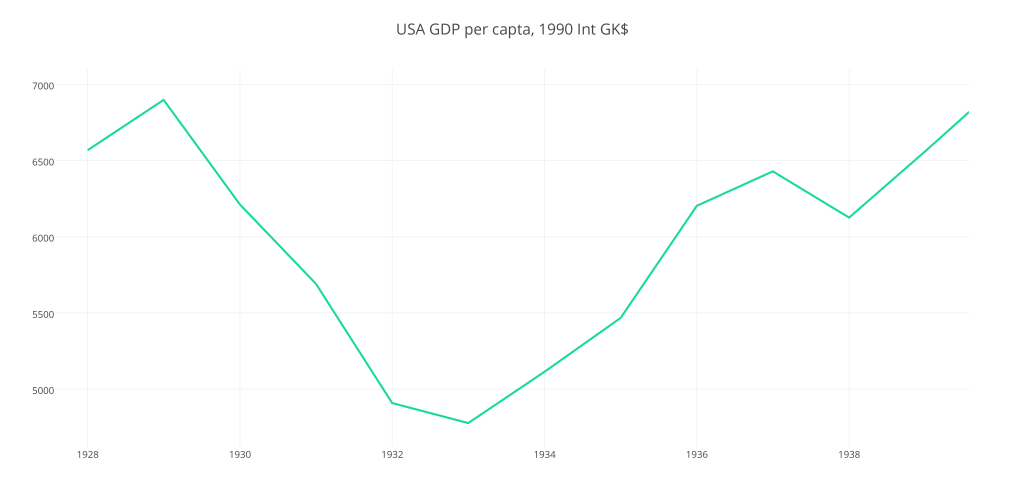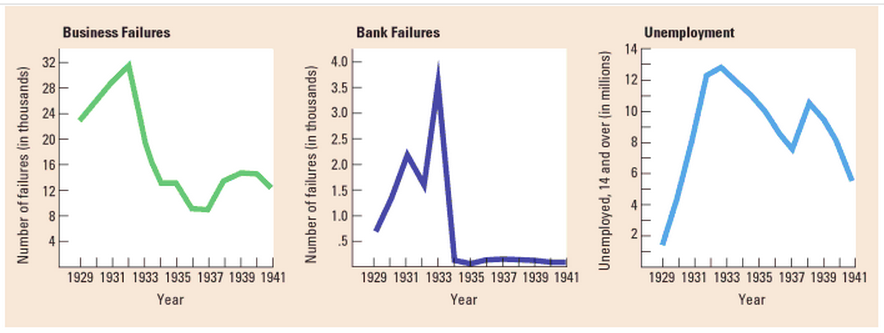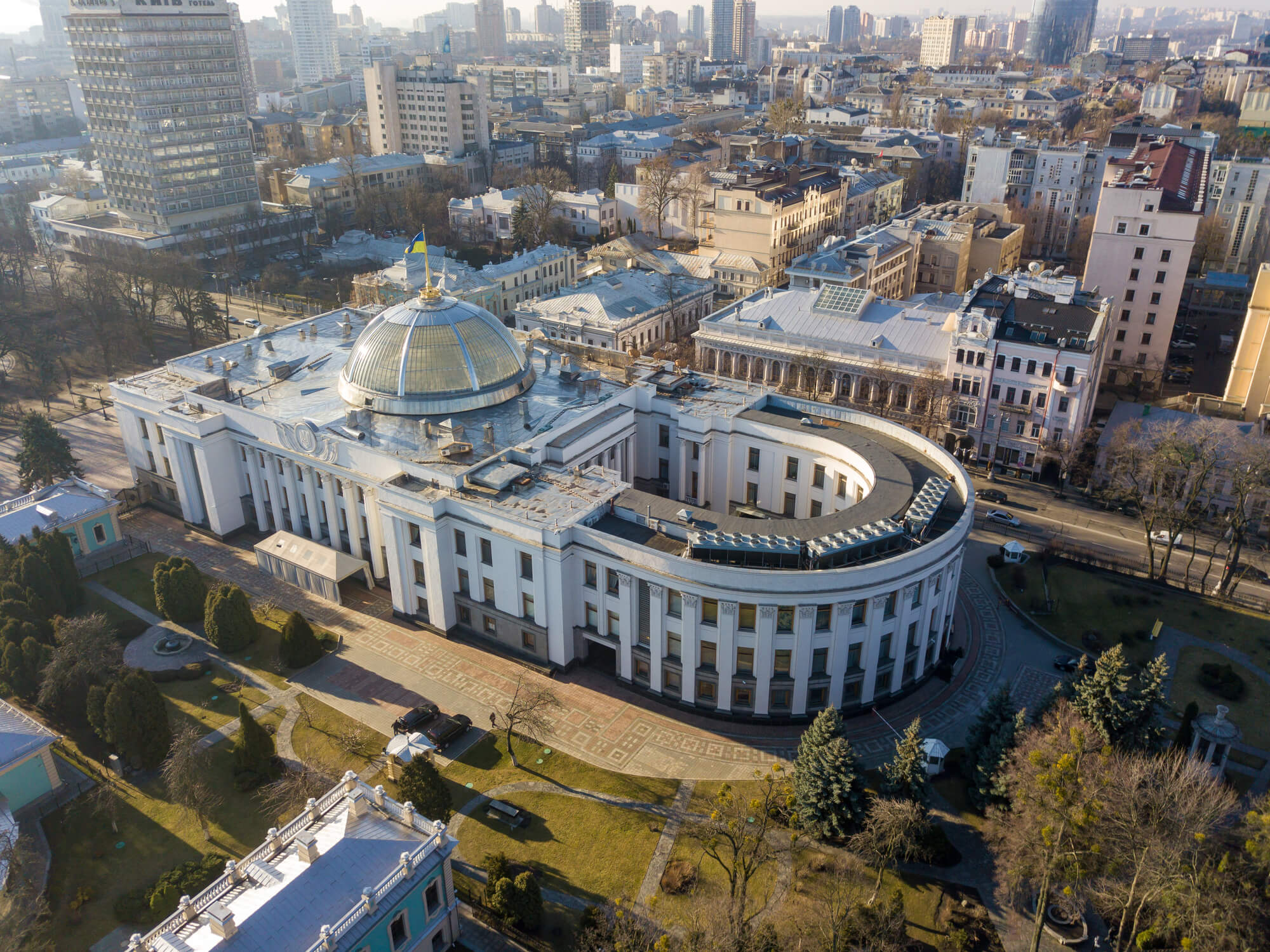Roosevelt’s presidency was an example of true proactive political leadership. His keys to success were: (i) trusted leadership and coherent teamwork; (ii) implementation of credible regime-shifting policies starting from the stabilization of the financial situation; (iii) balancing pivotal reforms with social relief measures. For modern Ukraine, this recipe can be implemented if the Ministers, as a group, will take a lead and consolidate the Parliament around one plan, the new professional team of the Central Bank will truly clean the banking system and gain trust of people, and if the social safety net will be created.
What can Ukrainian policymakers learn from Franklin D. Roosevelt, the 32nd President of the United States? FDR played an important role in US history. Many credit his “New Deal”[1] with ending the Great Depression, while others argue that his economic policy actually hindered economic progress (Ohanian and Cole, 2004). Most importantly, Roosevelt’s presidency was an example of true proactive political leadership.
Background
From 1929 to 1933, the US GNP declined by almost 30%, and exports fell by 62%. About 25% of the workforce was unemployed. The financial situation was deteriorating daily, fueled by a banking crisis, in which more than 9,000 banks closed their doors. FDR’s response to this unprecedented crisis was to initiate the “New Deal”- a series of programs enacted to fight the Depression. The New Deal had three pillars: Relief, Recovery and Reform. Relief measures comprised the most urgent efforts to help the poorest Americans. Nearly one third of the US population found themselves in severe hardship. Recovery introduced temporary programs to stimulate and restore the economy from recession, as well as to stabilize it and create growth conditions. Reform actions were necessary to fix the problems in the financial system.
The New Deal was orchestrated by a core group of FDR’s advisers who were brought in from academia and industry. They were known as the “Brain Trust”. During FDR’s first 100 days in office this team helped FDR enact fifteen major laws. Roosevelt also made every effort to gain the trust and full cooperation of Congress. The Congress worked more intensely than ever before, passing all the bills of the New Deal. The New Deal was all about improvisation and experiment. ”It is common sense to take a method and try it,” FDR said in the 1932 campaign: ‘‘if it fails, admit it frankly and try another. But above all, try something.”
Source of data: Maddison Project Database
From the economic perspective, establishing a social safety net and stabilizing the financial system were both successful policies. Some other economic policies resulted in suppressed competition, distorted prices and wages in many industries. In this article, however, we argue that it is important to understand how FDR implemented reforms rather than focusing solely on what he did.
Why Roosvelt was one of the best political leaders
What helped Roosevelt gain his legendary status as a reformer roughly 80 years ago is instructive for Ukraine now. The keys, from our perspective, were:
- Trusted leader and coherent teamwork. Roosevelt managed to create a well-coordinated system in which his advisors, major Government bodies, and most importantly Congress [1] [2] followed one plan and worked together effectively. He united the nation in the face of severe crisis.
- Implementation of credible regime-shifting policies starting with the stabilization of the financial situation. Fifteen bills of the New Deal proposing solutions in most problematic areas were adopted and implemented promptly and consistently.
- Balancing pivotal reforms with social relief measures. The Relief, Recovery, and Reform plan created sufficient political capital and national support to implement a new social vision in desperate times.
All these actions and efforts would not have been successful without effective communication. FDR invented his own method of political communication that helped him translate his messages directly to millions of the US citizens. Direct radio addresses by the President, dubbed Fireside Chats, became his signature communication method. FDR’s Fireside Chats allowed him to reach citizens quickly and efficiently, but most importantly they inspired trust. In the first of his Fireside Chats, Roosevelt started with the following words: “I want to tell you what has been done in the last few days, and why it was done, and what the next steps are going to be”. The President addressed Americans’ fears and worries, showed his involvement and asked for their support and collaboration: “It is your problem, my friends, your problem no less than it is mine”. After the great success of the first address, the President made nearly thirty more. Each of them concerned the main challenges facing the nation and helped build support for an active reform agenda.
How can we apply FDR`s lessons in Ukraine?
Trusted leader and coherent teamwork
The first three months of the Roosevelt presidency were probably the most intensive in US law-making history. The Congress adopted fifteen major bills with bipartisan support. [1]
In Ukraine, the circumstances under which the President and the Prime Minister came to power were similar in two important respects: 1) both the newly elected US President in 1933 and the newly elected Ukrainian politicians in 2014 enjoyed extraordinary support of the population and the political capital to carry out reforms; 2) the pressure of the economic and geopolitical situation was enormous, naturally favoring cooperation within the Congress/Parliament/Government.
At the same time there are substantial differences, which can help to articulate how exactly the power of leadership and teamwork could benefit Ukraine.
First, neither the Ukrainian President, nor the Prime Minister, managed to maintain an image of a fully trusted leader.
Second, the coalition didn`t become a united force capable of implementing reforms, in spite of the President and the Prime Minister’s parties have the majority in the Parliament (144 and 82 seats respectively). They had every opportunity to get all of the important laws passed, but they failed to capitalize on this for the benefit of the country. According to the latest data from the National Reforms Council, as of April 2, 2015 only 3% of the Association Agreement with the EU and 6% of the Coalition Agreement have been fully implemented.
That said, certain ministers and parliamentarians have successfully “passed” their first 100 days and could maintain the trust of both the population and the international community. From our perspective, political leadership in Ukraine should become associated not with a single personality – like that of the President or the Prime Minister. It should rather be associated with a group of people e.g., with the Cabinet of Ministers who can unite the Parliament around one plan. To gain more political capital for urgent and painful reforms, the government would have to put more emphasis on the consistency of its own agenda and collaboration between the ministries. They should create an image of a governmental crew capable of leading the country through the storm.
This is a difficult task, as Ukraine’s old bureaucratic system is time consuming. Coordinated work by professional press-centers can be a partial solution. At the same time, the ministers’ teams should consistently work on persuading the parliament to promptly adopt governmental laws needed for reforms. Concurrently, the parliament should shift its focus from inconsistent law-making to developing discipline, ridding themselves of corrupt and unprofessional colleagues, and securing united informed voting inside the parties. If the ministers and their teams will work closely with the coalition factions, their collective strength to pass important laws will increase dramatically, giving Ukrainians, donors, and investors a consistent and positive message.
Finally, the President, the government and the parliament should substantially improve communication. Today’s digital capabilities are much wider than one could have imagined a few years ago. Still, Ukrainians rarely hear the President and the Prime Minister conveying them as part of a reform agenda. These inconsistencies lead to further public disappointment and deepen the social crisis.
Implementation of credible regime-shifting policies starting with the stabilization of the financial situation
When Roosevelt came to office the country was in a deep economic recession. People and enterprises had no cash to repay their bank loans. Banks were losing their assets and were unable to sell what was put up for these loans. The state couldn’t intervene by bailing out the banks because before 1933 the US could only issue money backed by gold. The money supply reduced significantly. Banks were unable to return deposits to their clients, which created panic among those who were trying to withdraw money from the banks. Similarly, employers didn’t have cash to pay the workers and they issued checks that could not be cashed. Numerous banks were closed. A wave of “bank holidays” swept many states, but it didn’t help. These circumstances led to a complete loss of confidence in the banking system.
The Ukrainian banking system is not in such a severe crisis because its banks are still functioning. However, as in the US back in 1933, Ukraine has not been fully successful in macroeconomic stabilization mainly because of the lack of confidence in the banking system and the uncontrolled outflow of deposits – more than 364 bln UAH (13,7%) and 19,4 bln USD (37,2%) were withdrawn in 2014. As of May 1, 2015, since the beginning of the year the amount of deposits in UAH fell by 5%, and in the foreign currency by 16,3%. The Ukrainian people continue to distrust both the National Bank of Ukraine (NBU) and the state as a whole.
How did FDR stabilize the financial situation and encourage Americans to put their money back in the banks?
- On the second day of his Presidency, the banking system was shut down by declaring a Bank Holiday. Banks were to suspend all transactions for several days. During this time, banks had to submit financial statements of their condition and the government determined if they could reopen. An army of examiners checked the solvency of the banks across the US. They certified the sound banks and closed underperforming banks.
- During the President’s first Fireside Chat, he appealed to the nation as a whole, explaining the banking crisis as well as his plan for recovery. He asked the people not to withdraw their deposits when the banks reopened.
- He worked with the Congress to pass the Emergency Banking Act aimed at reforming the banking system.
The Emergency Banking Act gave the President power to restore confidence in the banking system. Currently in Ukraine, the “political elite”, including the Head of the NBU, has neither the political capital, nor the trust of the public to inspire confidence in the banking system. Based on the lessons learned from the FDR’s policies, we would like to outline several recommendations on how to restore public confidence:
- Trusted leader(s) is needed to restore confidence in the banking system. A number of highly motivated professionals have recently joined the NBU. This team can lead the regime shift. For instance, the committee of the monetary policy can go public and together with the Head of the NBU ensure people that they have a clear plan and will carry the responsibility for its successful implementation.
- The NBU should continue cleaning the banking system. The NBU has had a promising start, shuttering 49 unsound banks, and setting new requirements for the disclosure of the ownership structure of the banks. But the system is plagued not only by “bad” banks, but also by misleading financial reports and the tendency for banks to hide risky assets. Another issue is that the ownership structure of the biggest banks doesn’t inspire confidence. Consequently, citizens have very little trust in the banking system. Notably, little has been done to convince people that the state would protect them against the vested interests of the owners with questionable reputation.
- The media, international community, and civil society should put pressure on the banks and their owners to make them unambiguous and articulate their policies.
- Communication from the NBU should be regular and proactive. All instruments, messages and channels should be relevant for the target audience. It is important to talk to people in plain language, to explain to them what they don`t understand, and to address their uncertainties.
Balancing pivotal reforms with social relief measures
In 1933, nearly 25% of the US workforce was unemployed. The private sector was underperforming and could not absorb the 13 million people who were out of work. Under the circumstances it was important to provide broad social support to the people as the government worked to restore a prosperous economy.
Source of the table: Berkin, Carol, et al. Making America: A History of the United States. Vol. 2: From 1865. Sixth Edition. 2014. p.625 Roosevelt found a solution – the state hired the unemployed.
Roosevelt found a solution – the state hired the unemployed. In particular, Relief measures that were introduced established new government agencies and introduced nation-wide projects:
- The Federal Emergency Relief Administration (FERA) gave grants from the Federal Government to local governments for agricultural, construction, educational and arts projects.
- The Civic Works Administration (CWA) provided temporary employment, mainly for unskilled workers to rebuild schools, hospitals, construct bridges, and modernize airports and repair roads.
- The Civilian Conservation Corps (CCC) created thousands of jobs for young men, employing them to plant trees, build dams and fight fires [3] [4]. The CCC also helped to build infrastructure for the Tennessee Valley Authority Project, which was aimed at elevating the standard of living and services in the impoverished state of Tennessee in the Southeastern United States.
Ukraine could use similar social relief efforts [5]. The country has been in a proxy war with Russia for more than a year, the economy has been hurt by a significant reduction in production, currency devaluation, a decrease in purchasing power, tariff increases and growing unemployment. The safety net to protect vulnerable population groups is very weak, the health crisis is worsening, and rehabilitation measures for soldiers and refugees are only in their nascent stages. The recently passed law №245-VIII, which foresees a number of measures to support unemployed refugees is not sufficient. To date, no systemic Relief measures have been introduced in Ukraine.
The Relief Strategy and Economic Recovery
According to the latest data of the Ministry of Social Policy, as of May 25, 2015 there are over 1,307,432 IDPs (internally displaced people) in Ukraine the majority of whom are either unemployed or not in the labor force. The government should initiate programs to help employ both categories of the workforce.
- The geography of the cities and regions hosting IDPs shows that the lion’s share – 580,700 people – moved to the regions of Donetsk and Lugansk that are under the control of the Ukrainian authorities. Thus, the unemployed IDPs could be engaged in various restoration and modernization projects of the Donbass infrastructure – roads, bridges, schools and hospitals, as well as in agricultural and education sectors. Two pilot projects on the restoration of the regions of Donbass impoverished and damaged by the war can be implemented in two cities, for example Mariupol and Sloviansk, or Kramatorsk and Severodonetsk. These projects aimed at rebuilding infrastructure would employ a great number of IDPs, would lay the groundwork for an economic recovery in the region, and would return credibility to the Ukrainian authorities. The State Agency of Ukraine for Donbass Restoration, which was established on September 10, 2014, could coordinate these efforts. In addition to public funds, the Agency could also attract international technical assistance. Japan has already expressed its willingness to allocate funds for Donbass, in amount of $4.2 million, to restore the infrastructure of the region. France and Germany, as well as the EIB, are also ready to help.
- As of the end of the third quarter of 2014, only 1093 (33%) of 3350 state enterprises were working at least with some profit. All the rest were either not working, or were working with losses, or there were no information about them. The state surely cannot afford supporting the uncompetitive and loss-making businesses. Thus, after thorough evaluation and analysis, many companies should be privatized. Those that remain state owned should be turned into well-managed transparent companies while others should be liquidated. Inefficient but promising enterprises should be given new professional management, preferably with international experience.
- As of now, the Ukrainian economy is quite diversified and there is no single industry acting as a driving force for the economy. According to widely shared opinion, agriculture, information technology and energy are the most promising. However, any other industry can become successful after serious market liberalization takes place, – machinery, textile and food industries, defense and service sectors,etc. Notably, in the process of modernization and investments inflow, these industries can be filled with digital innovations. New trends such as mobile solutions, cloud technology and data analysis provide a range of new opportunities for business services in the economy.
- The government should create favorable conditions for investors to support the introduction of digital technologies. Jointly with local businesses, international companies, and foreign donors it can create new jobs and workplaces by empowering entrepreneurship and attracting innovative technologies to existing firms with investments. Close to 311,700 IDPs moved to Dnipropetrovsk, Kharkiv and Zaporizhia regions. This situation can be transformed into a successful case of creative destruction. Dnipropetrovsk or Kharkiv have the potential to become the IT-Hubs in the East, in addition to Lviv in the West (which recently made the first step to digital management). Young people should get wide access to digital knowledge, training, and e-education. The government should engage investors and local businesses in the dialogue to bring innovative, digital companies to Ukraine, and promote the potential for R&D in the country.
To date, the achievements of Ukraine’s leaders do not amount for a deep reform similar to what Roosevelt and the US Congress have accomplished during the Great Depression. While the Ukrainian government and parliament have accelerated the pace of reforms in recent months, they should do much more. It is high time for them to capitalize on the broad support from the Ukrainian public and the international community, and move forward with fundamental political and economic reforms.
The authors are grateful to Sasha Borovik for inspiration and to Mike Duane for valuable suggestions
Note
[1] “New Deal” is a series of domestic programs enacted in US in 1933-1938, and in some later periods. The first “New Deal” was introduced by FDR.
Attention
The authors do not work for, consult to, own shares in or receive funding from any company or organization that would benefit from this article, and have no relevant affiliations







